Green Birds I Birds by Color - Types & Picture
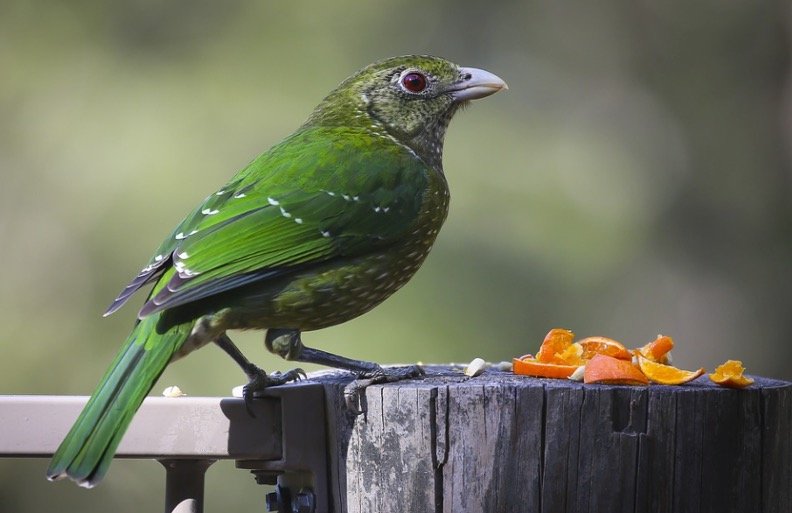
In North America, there are numerous green birds, especially in the spring and summer when migrating warblers and hummingbirds are present. Learn everything here to know about green birds so you can recognize them.
We’ve added the states you may find them in, as well as whether or not they migrate, to assist you in identifying any green birds you may have seen. Some green birds may seem yellow, brown, or grey at other times, but We’ve included all the North American birds as well as few non-North America green birds that appear green under certain lighting circumstances.
1. Mitred Parakeet
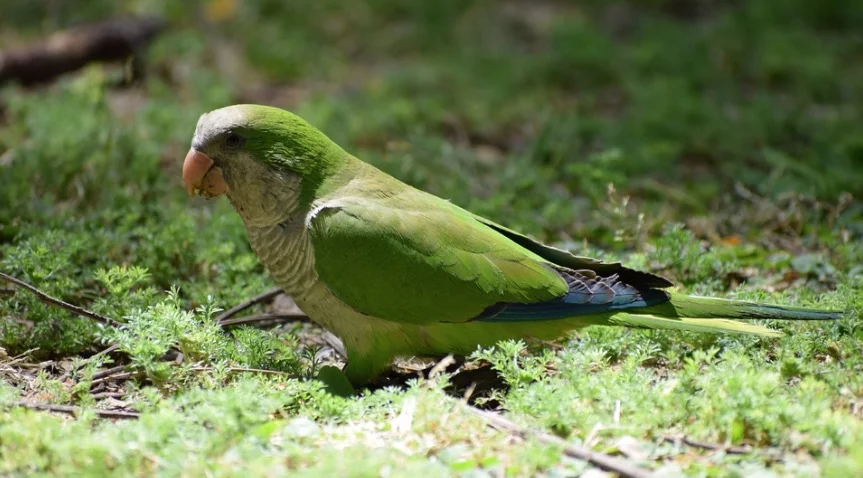
The face and breasts of a little brilliant green parakeet are greyish. Blue runs along the flying feathers as well. The size of a Monk Parakeet is comparable to that of a European Starling. It measures 17.7 to 20.9 inches in length and weighs 90 to 120 grams.
Monk parakeets are native to South America, but they have recently established themselves in a number of southern US towns. Some people have even moved as far north as New York. They are adaptive birds that may eat from orchards and gardens’ fruit plants.
2. Kentucky Warblers
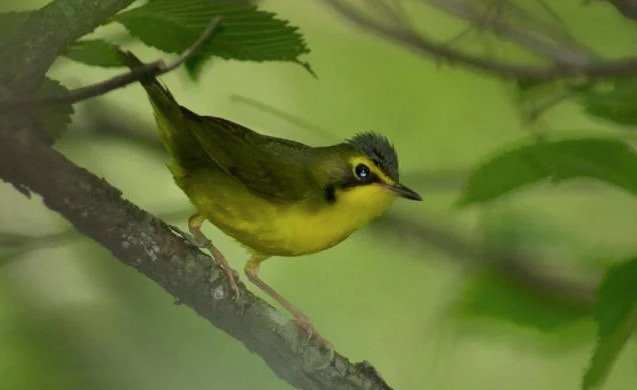
Kentucky Warblers have an olive-green back with a yellow underbelly. Males have black crowns and black marks on their faces. Kentucky Warblers breed in the eastern United States and migrate to Mexico and Central America for the winter.
It has a wingspan of 7.9 to 8.7 inches, a length of 5.1 inches, and a weight of 13 to 14 grams. Kentucky Warblers can be found on the ground in deciduous woods, making them easier to see. Kentucky Warbler nests are also extremely common on the ground.
3. Wilson's Warblers
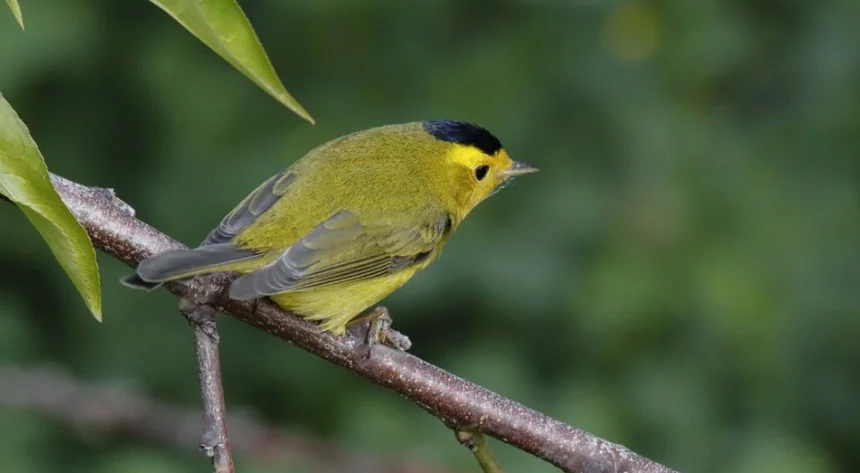
Wilson’s Warblers are little yellow warblers with black male caps and olive female caps. Wilson’s Warbler females have olive-green backs and yellow undersides. It measures 5.6 to 6.7 inches in wingspan, 3.9 to 4.7 inches in length, and weighs 5 to 10 grams.
Wilson’s Warblers breed in Canada, Alaska, and the northwest United States, although they can be observed in all 50 states during migratory. In the winter, they spend time in Mexico and Central America. Look for Wilson’s Warblers in thickets beside waterways.
4. Black-throated Green Warbler

A little yellow songbird with an olive-yellow back and a yellow face and head. They are pale beneath and have black striping on the sides and wings. It has a wingspan of 6.7 to 7.9 inches, a length of 4.3 to 4.7 inches, and weighs 7 to 11 grams.
Black-throated Green Warblers are most visible during their long journey across the Eastern United States and into Canada, where they reproduce. They feed insects high up in the trees and may be distinguished from other little yellow birds by their black neck.
5. Green Jay
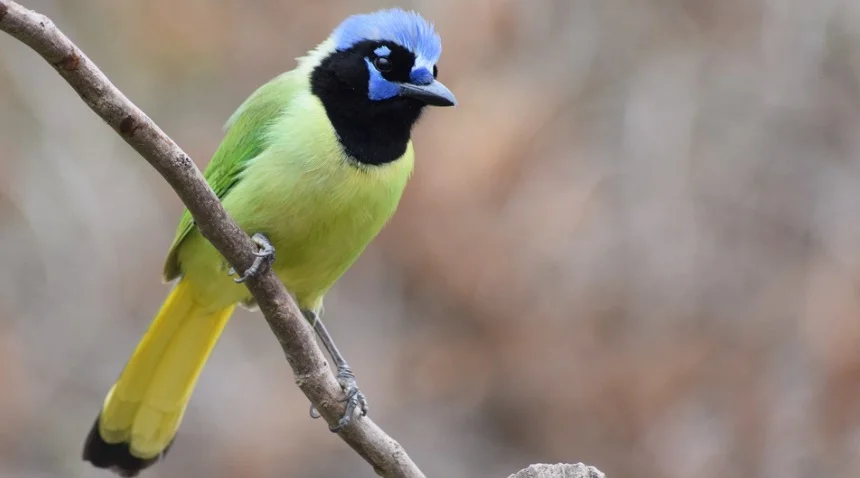
Only spotted in southern Texas, this brilliant Green Jay is an uncommon discovery in the United States. Their backs are dark green, their bellies are lighter, and their heads are vivid blue and black. It measures 11.4 inches in length and weighs 66 to 110 grams. Green Jays may be seen throughout the Mexican and Central American shores.
In southeastern Texas, they can also be found. They graze on insects and seeds and may be found in forests near streams and water. You could encounter one at bird feeders in Texas wildlife refuges if you’re lucky.
6. Nanday Parakeet
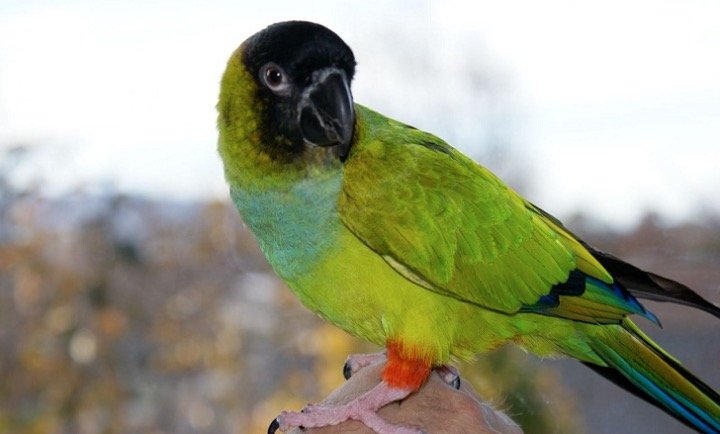
The Nanday parakeet, another renowned pet bird that has escaped, is a brilliant green bird with black heads. Originally, they were known as the Black-hooded Parakeet. They’ve now established themselves in Los Angeles, Florida, and Arizona.
7. Red-eyed Vireos
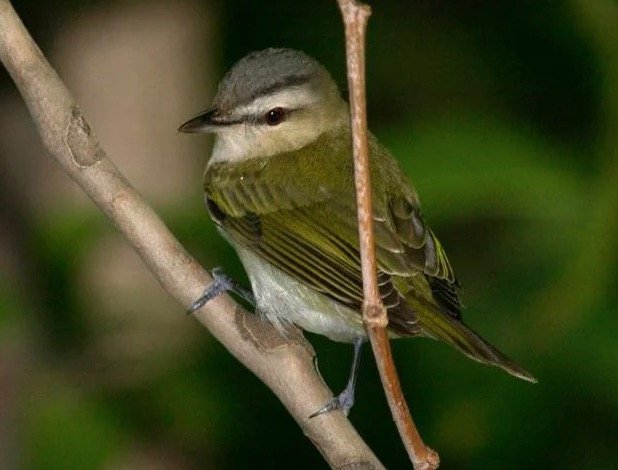
Red-eyed Vireos have olive-green backs and white underbelly. Their crowns are grey with a white band over the eye. From afar or in certain lighting circumstances, their crimson eyes may look gloomy. It measures 9.1 to 9.8 inches in wingspan, 4.7 to 5.1 inches in length, and weighs 12 to 26 grams.
Except for Alaska, the extreme north of Canada, and the Southwestern States, Red-eyed Vireos spend their summers mating over much of Canada and the United States. In the winter, they spend time in South America. During the summer, they are plentiful in woods, although they prefer to stay high in the canopy.
8. White-eyed Vireos
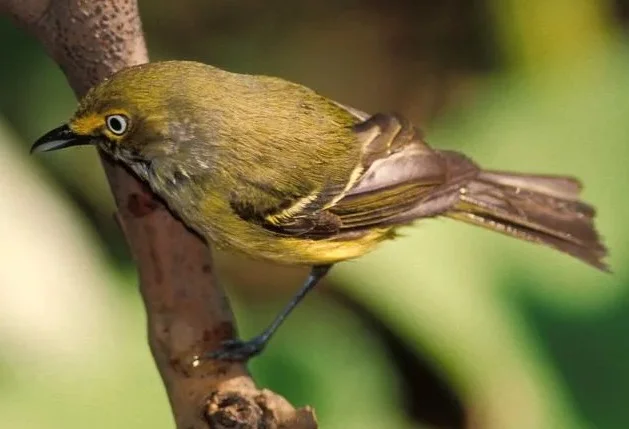
Gray and yellow tones on a little songbird. White-eyed Vireos have a grey head, white breast and throat, yellow sides with darker wings and two white wingbars with black streaking, and two white wingbars with black streaking.
They have yellow around their eyes and on their forehead, as well as a white eye. It measures 6.7 inches in wingspan, 4.3 to 5.1 inches in length, and weighs 10 to 14 grams. Summering in the southeastern United States, hiding in thickets and out of sight.
They spend their winters around the southeast coast of the United States, Mexico, and the Caribbean. Insects, flies, and spiders are eaten by White-eyed Vireos in overgrown pastures and brambles.
9. Green Parakeets
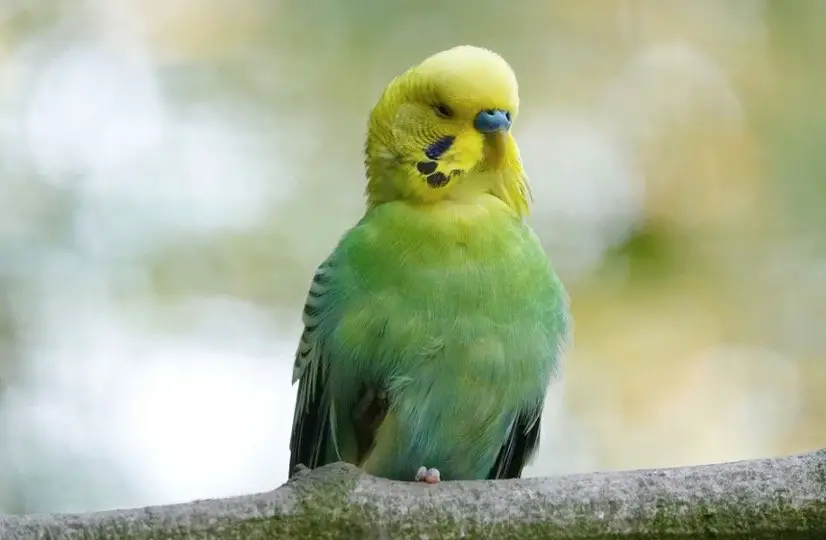
Green parakeets are typically found in Mexico and Central America, but escaped pet birds and a growing northerly range have led to their appearance in Texas and other warm states.
10. Ruby-throated Hummingbirds
The male Ruby-throated Hummingbirds have an iridescent red throat and a vivid green top and crest with a gray-white underbelly. Female Ruby-throated Hummingbirds have brownish crowns and sides and are green on the back and white underside. It measures 3.1 to 4.3 inches in wingspan, 2.8 to 3.5 inches in length, and weighs 2 to 6 grams.
The Ruby-throated Hummingbird seems to be the only hummingbird that breeds in eastern North America, after which it migrates to Central America for the winter. Some move across the Gulf of Mexico, while others migrate around the coast of Texas.
Hummingbirds with ruby-throated throats arrive in the United States in February and therefore do not visit to northern states and Canada until May to reproduce. Males often arrive one or two weeks before females in the spring.
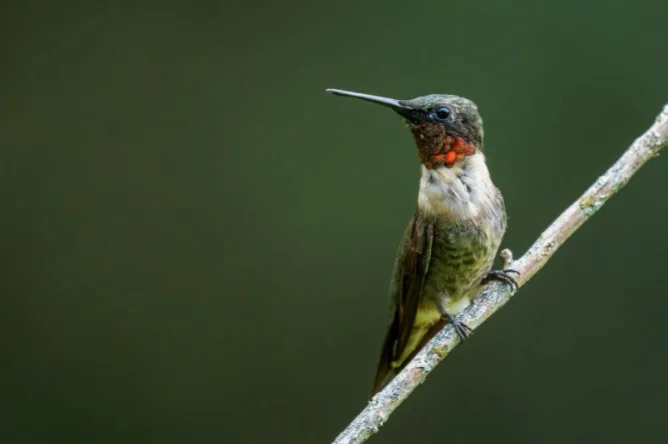
Ruby-throated Hummingbirds travel south in the fall, gathering around the Gulf Coast of Texas in September before making the final push south for the winter. These little birds fly from one nectar source to another, catching insects in mid-flight or from spider webs.
They come to a halt on a little twig now and again, but their legs are so short that they can only shuffle along a perch. In the summer, the ideal areas to look for them are blooming gardens or woodland margins. They may also be found in cities, particularly near nectar feeders. In their protection of blooms and feeders, male Ruby-throated Hummingbirds may be violent.
They don’t stay around long after mating, and by early August, they may have moved away. Ruby-throated females form nests consisting of thistle or dandelion down tied together with spider silk on narrow trees. They deposit 1-3 tiny eggs that are barely 0.6 in in diameter (1.3cm).
11. Rivoli's Hummingbirds
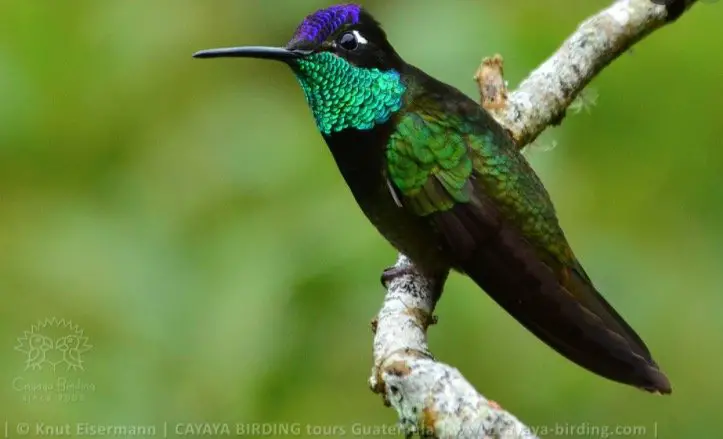
Rivoli’s Hummingbirds are huge hummingbirds with more striking colours than other hummingbirds, having a shimmering purple head in addition to the more common emerald green iridescent throat in males. Females are dark green on the back and grey underside, while males are dark green on the back and greyish underneath.
It is 4.3-5.5 inches in length and weighs 7 to 8 grams. Rivoli’s Hummingbirds are native to Mexico and Central America, although some travel north to southern Arizona, New Mexico, and southwestern Texas in the winter. They prefer pine-oak woodlands in hilly areas, but they may visit feeders across their range. They construct their nests at a pretty high altitude.
12. White-eared Hummingbird
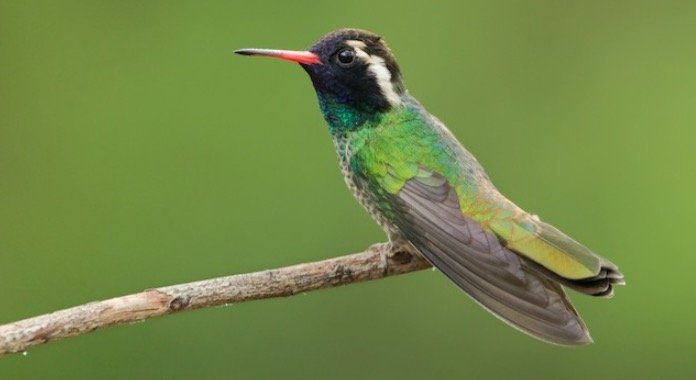
Both males and females of the White-eared Hummingbird have green back sides and breasts, a black head, and a white eyestripe. They have crimson beaks with a black tip. Males have a shiny turquoise green throat and face with violet spots. It measures 3.5 to 4 inches in length and weighs 3 to 4 grams.
White-eared Hummingbirds can be found in the United States from Nicaragua to the highlands of southern Arizona, southwestern New Mexico, and western Texas, although they are uncommon. They normally lay their eggs in northern and central Mexico between March and August, or later in July in Arizona, and they can produce up to three broods per year.
In March, they travel to the southern United States, where they stay until early September. White-eared Hummingbirds live in scrubby vegetation, woodlands, or backyards, and they nest in bushes or low trees.
13. Cinnamon Hummingbirds
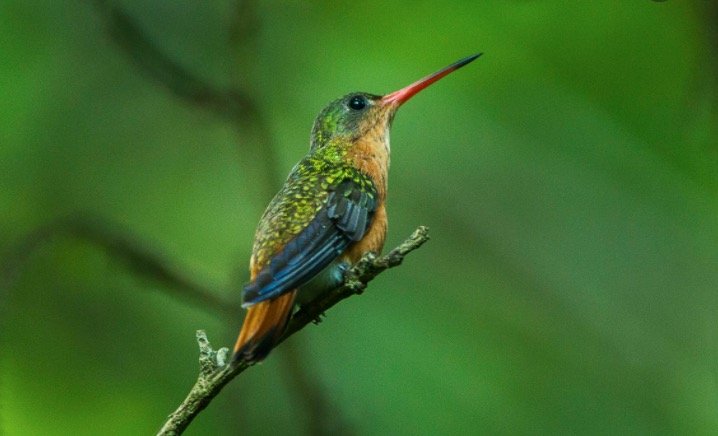
Cinnamon Hummingbirds have a bronze-green back and a cinnamon-colored underbelly from beneath their chin to their tail, as their name indicates. Their beaks have a black tip and their tails are crimson. It measures 3.9 inches in length and weighs up to 5 grams.
Cinnamon Hummingbirds are usually found from northern Mexico to Costa Rica, although a few have been spotted in the southern United States. They eat on nectar and insects in pine and oak forests, as well as open scrubby habitats.
14. Black-chinned Hummingbirds
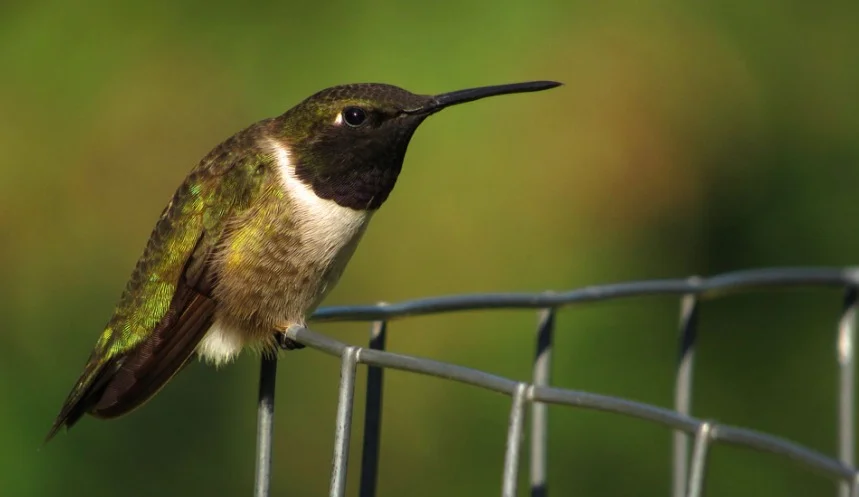
Black-chinned Hummingbirds have a dull metallic green back and grayish-white underbelly. Females have a light neck and white tips on their tail feathers, while males have a black throat with a thin iridescent purple foundation.
It has a 4.3-inch wingspan, a 3.5-inch length, and weighs between 2.3 and 4.9 grams. In the summer, Black-chinned Hummingbirds breed primarily inland, from British Columbia to Baja California. They may migrate to higher mountain locations with numerous blooms after mating before wintering in western Mexico, southern California, and the Gulf Coast.
The Black-chinned Hummingbird migrates between March and September. They devour nectar, tiny insects, and spiders, and when feeding on nectar, their tongues may lick 13-17 times per second. Black-chinned Hummingbirds build their nests out of plant down and spider silk, and they lay two white small eggs that are barely 0.6 in long (1.3 cm).
Black-chinned Hummingbirds are frequently spotted perching on tiny bare branches at the tops of dead trees, and they frequently return to a favourite perch. They can be found around canyons and rivers, as well as under shade oak trees.
15. Violet-green Swallow
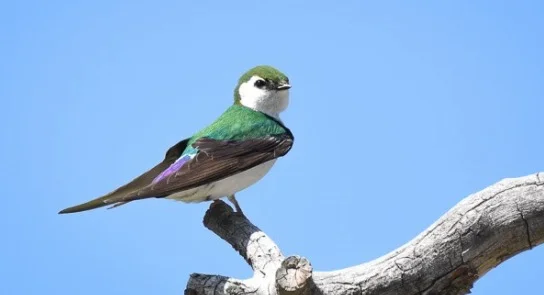
A Violet-green Swallow has just flown by if you witness a flash of dazzling white against a dark green and bronze back. The hue of their lower back and wings is an iridescent violet that catches the light. It has a 10.6-inch wingspan, a 4.7-inch length, and weighs 14 grams.
Violet-green Swallows breed in western states of the United States, as well as in Canada and Alaska. In the winter, they spend time in Mexico and Central America. Early morning, they can be spotted among open forests around ponds, rivers, and lakes.
16. Ruby-crowned Kinglets
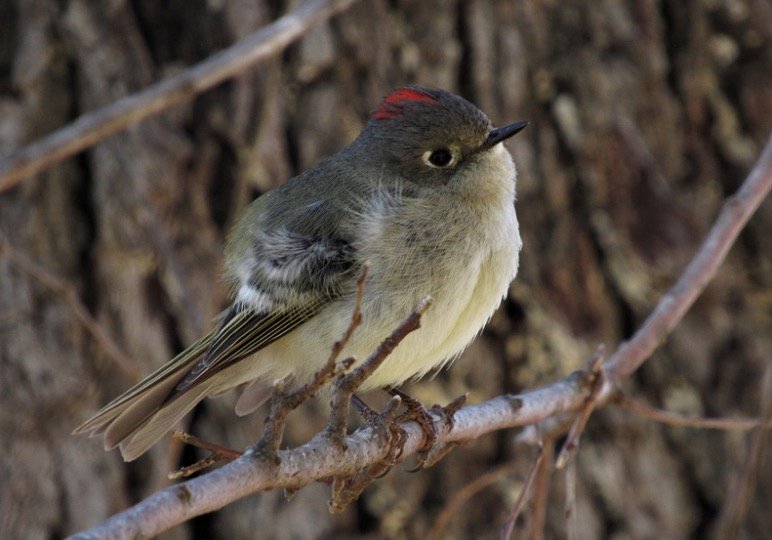
Ruby-crowned Kinglets are little olive-green songbirds with a vivid red crown on the males that is normally flat and difficult to notice, but spectacular if you do. It measures 6.3 to 7.1 inches in wingspan, 3.5 to 4.3 inches in length, and weighs 5 to 10 grams.
Ruby-crowned Kinglets breed in Canada and the Western Rockies before wintering in the southern and south-western United States and Mexico. They’re also visible during migration, when they’re in large numbers.
Ruby-crowned Kinglets are fast-moving, silent birds that dart among the foliage of lower branches, bushes, and trees in search of spiders and insects. For hulled sunflower seeds, peanut hearts, and mealworms, they come to suet feeders or platform feeders.
17. Olive Sparrow
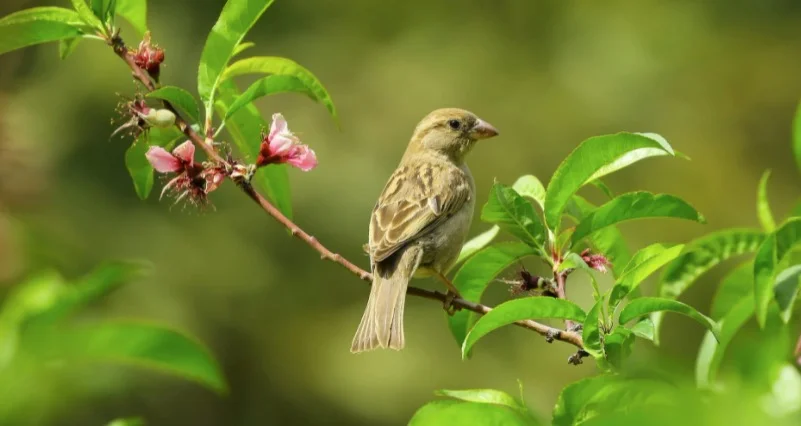
A little-known sparrow of dense thorn scrub, the Olive Sparrow hops on the ground, never straying far from cover. This large, towhee-like sparrow is gray overall with an olive back and brown stripes on the head. It holds its rather long tail up while foraging for seeds and insects in the undergrowth. In the United States the Olive Sparrow occurs only in southern Texas, but it also occurs south of the border with a patchy distribution into Central America.
18. Short-tailed Magpies
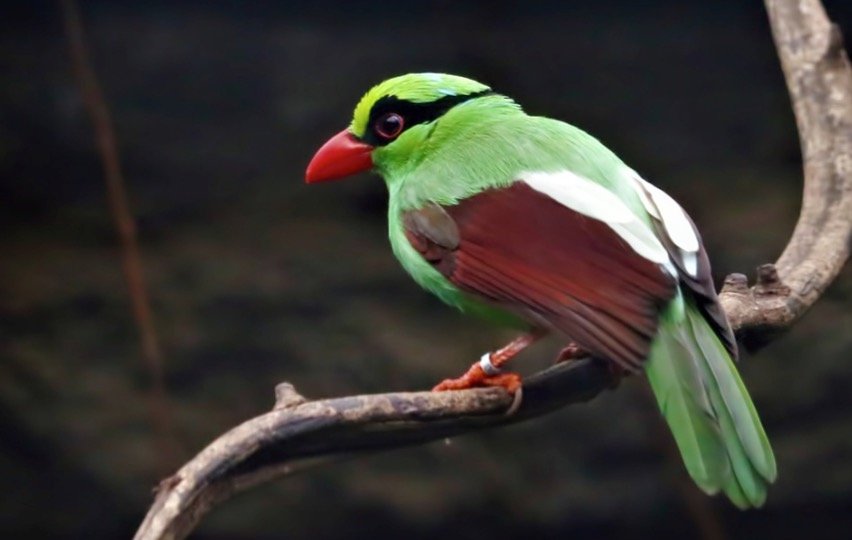
The Short-tailed Magpies (Cissa thalassina) or Short-tailed Green Magpies are endemic to montane forests on the southeast Asian islands of Borneo and Java. They can typically found in thick vegetation in the mid and upper storeys of forests. Their natural plumage is mostly green – although the plumage of captive birds in particular often appears to be more turquoise (possibly caused by low-carotenoid diet).
19. Green Catbird
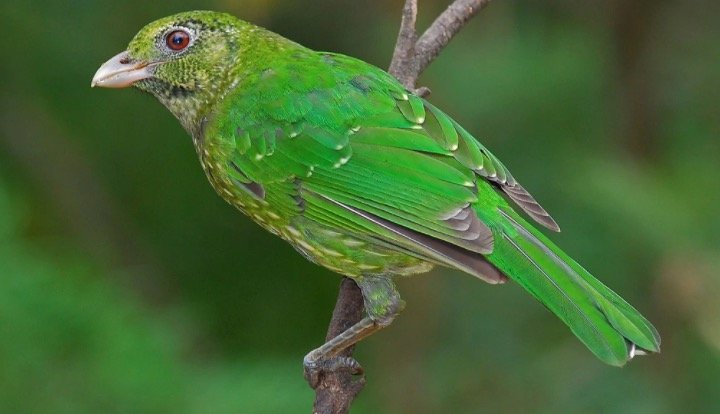
The Green Catbird is a large, stout green bird, spotted white, with a dusky crown, nape and face and a white bill. The eye is red. Juveniles are duller in colour. The Green Catbird eats fruit, notably figs, flowers, and other plant material. It will also kill baby birds to feed its own young during breeding season and will eat small reptiles too. They usually feed in pairs or small groups, moiving from tree to tree in the mid to upper canopy.
20. Superb Fruit Dove
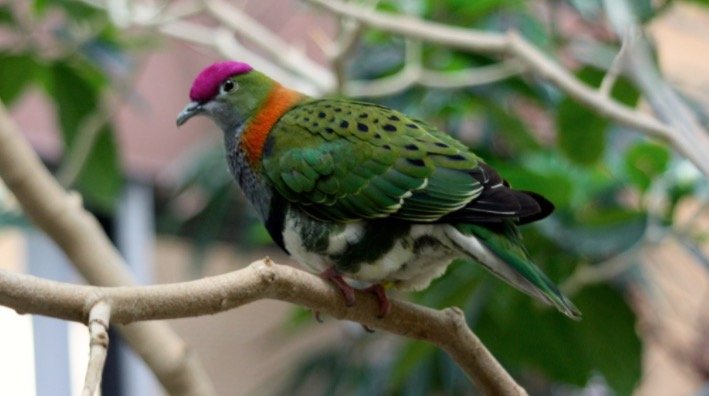
The Superb Fruit-Dove is a small colourful pigeon of the tree canopy. It is a compact bird, with short rounded wings and a short tail. The male has a purple crown, an orange hindneck, a blue-black breastband that separates a grey upper breast from white underparts. These are partly barred green, and the rest of the body is green. The green tail has grey tips. The female is green, with a grey breast and white underparts. There is a smallish purple patch on the crown.
21. Green Honeycreeper
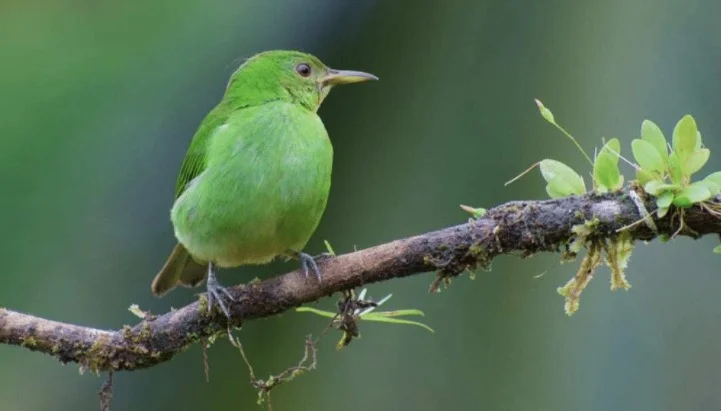
The Green Honeycreeper (Chlorophanes spiza) is a small tanager that occurs naturally from southern Mexico south to Brazil – where they are known as Saí-verde. The Green Honeycreeper averages 13-14 cm (5-5.5 in) in length and weighs between 14 to 23 grams. It has a long, sharply pointed, black and yellow, decurved beak.
Males and females are easily identified. The male is mostly a glossy blue-tinged green, with some of the wing feathers, edgings on wings and tail being somewhat darker. He has a black head and a mostly bright yellow bill. His legs are greyish and his eyes are brick-red – redder than those of the female.
22. Green Broadbill
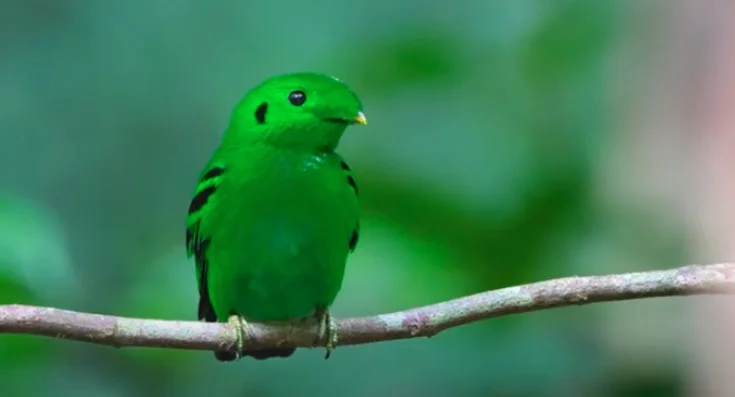
This type of little green bird of Sumatra and Borneo has a stubby tail and a crest at the front of its face that hides its tiny beak. Its plumage is rich, mossy emerald green, and it has contrasting black bands on its wings and a black patch over its ear. Its eyes are shiny black, round and beady.
The Broadbill resembles a nightjar, for its small beak reveals an enormous mouth when it opens. Its green color allows it to nearly disappear into the evergreen forests where it lives. It eats figs and helps distribute the seeds. It will also take insects now and then. Unfortunately, the conservation status of the green broadbill is near threatened due to habitat loss.









